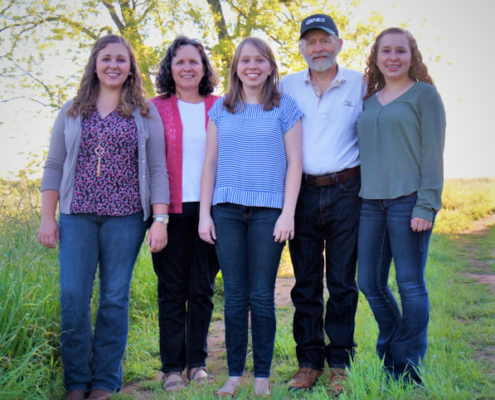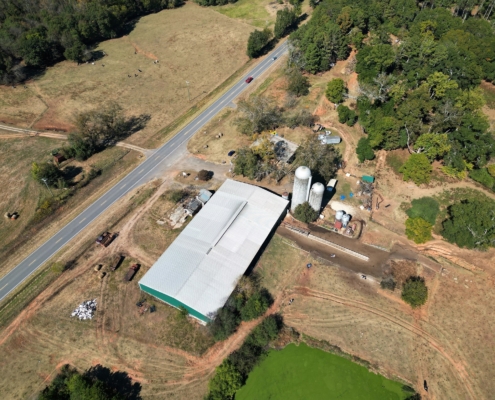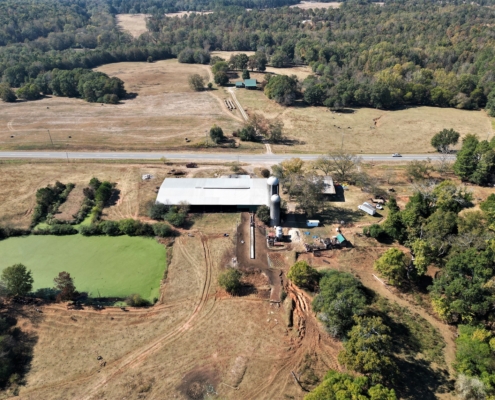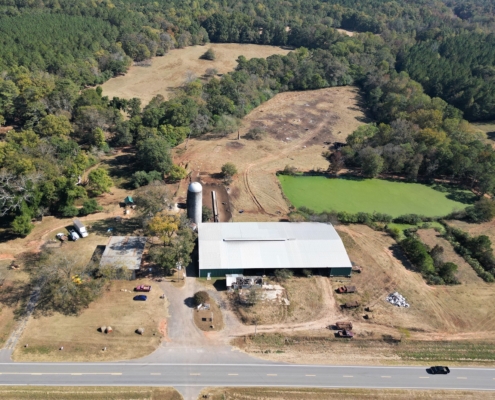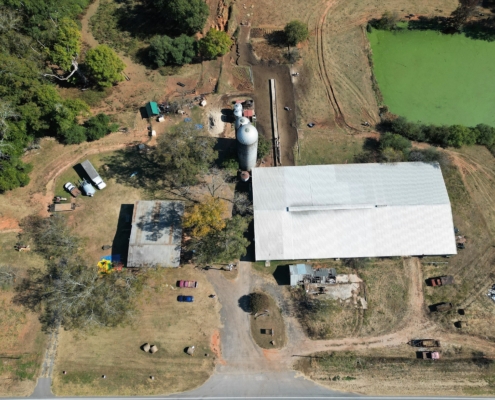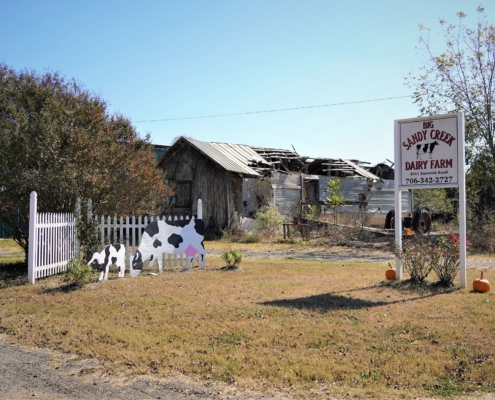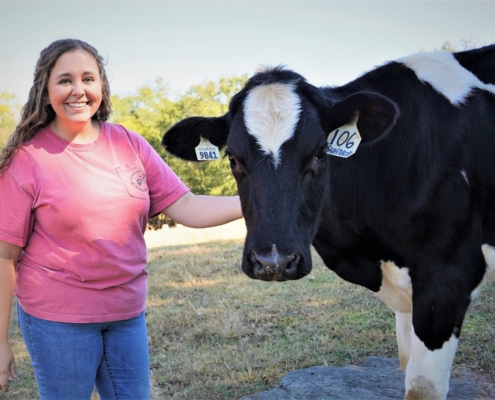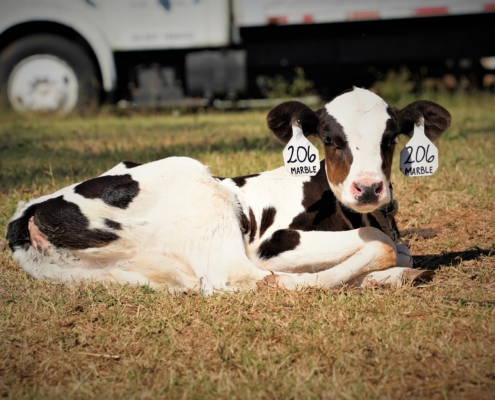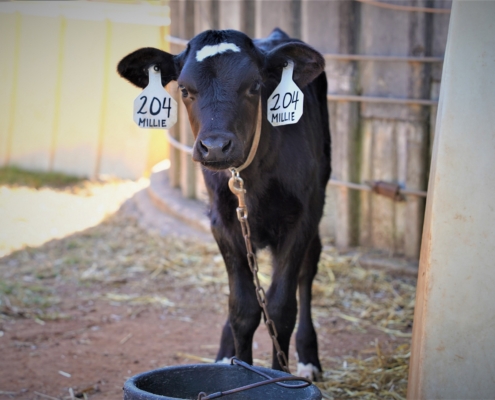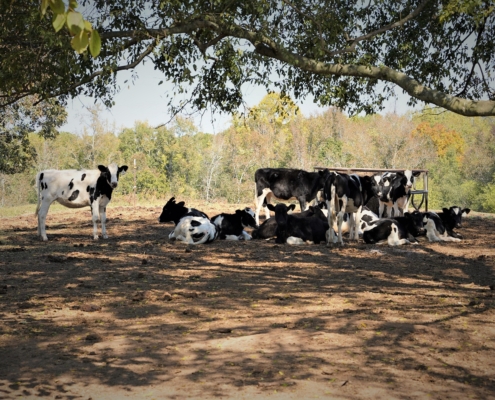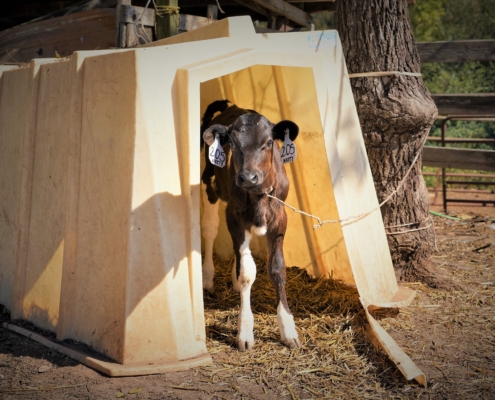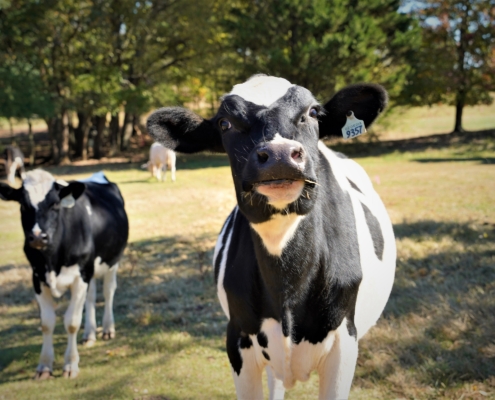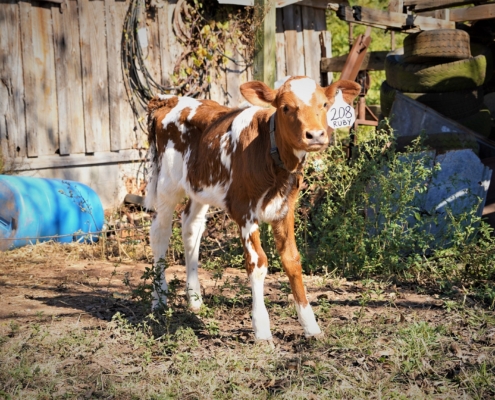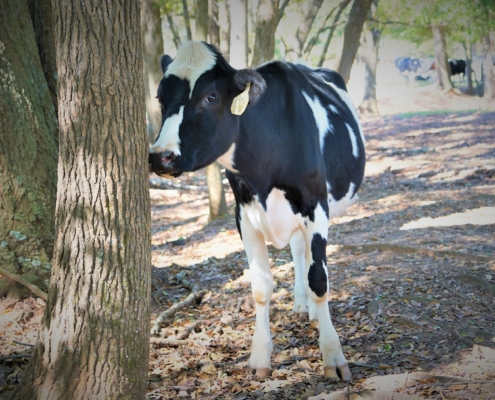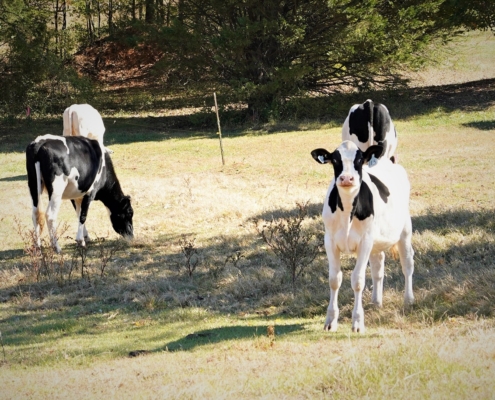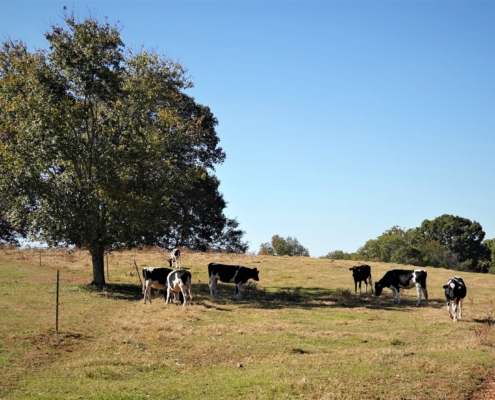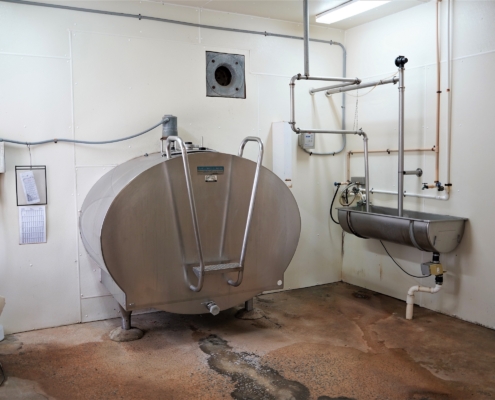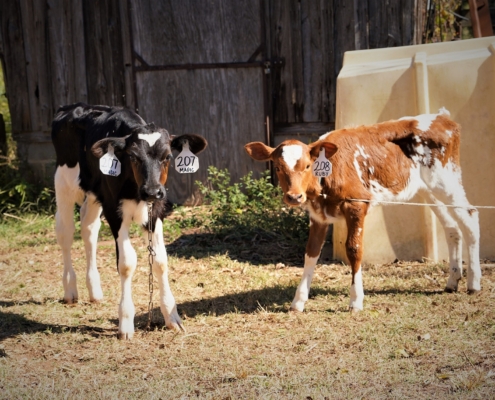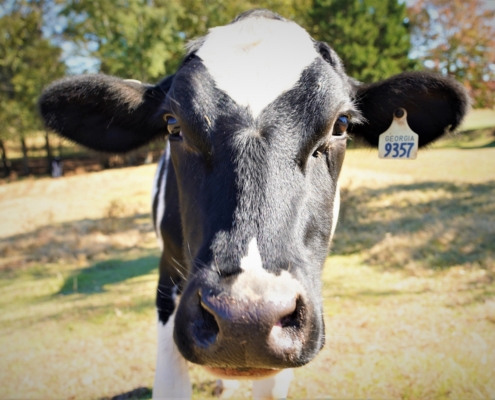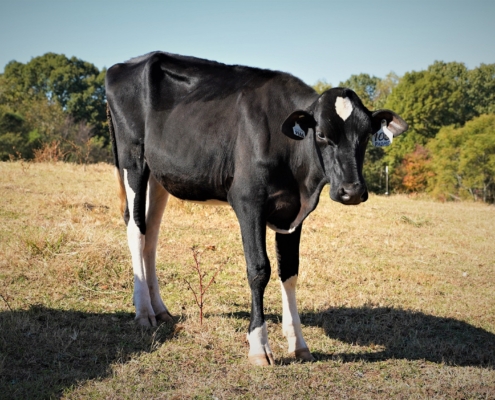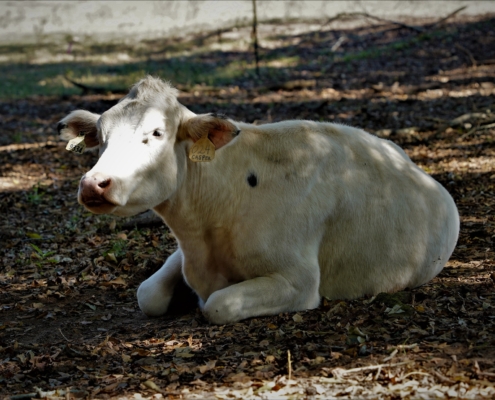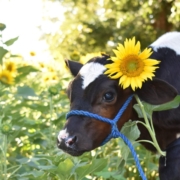 Big Sandy Creek Dairy
Big Sandy Creek Dairy
Welcome to Big Sandy Creek Dairy!
Meet Farmer John, Julie, Katelin, Alissa, and Leah Benkoski!
Together as a family they run Big Sandy Creek Dairy located right here in Morgan County, off Hwy 83 (Bostwick Rd).
Their mission is to provide a wholesome, all-natural product while providing the best care for their animals, educating consumers, and supporting the community! Check out the photographs of their farm and get to know Big Sandy Creek Dairy in the Q & A session below!
About the Farm
The Benkoski Family has been in the dairy farming business in Morgan County for over 75 years! John Benkoski Sr. established Big Sandy Creek Dairy in 1947, relocating it from Connecticut, where the winters had proved to be too harsh. Now owned and operated by John Benkoski Jr. and his family, the dairy continues to provide milk for brands such as Mayfield, PET, and Borden.
Resting on 200 acres, the Benkoski Family cares for approximately eighty Holstein dairy cows, which are milked twice daily. Afterwards, the milk is stored in a bulk tank, where the temperature is regulated and kept under 40 degrees Fahrenheit, until it is picked up and transported for processing.
Specializing in agritourism, the Benkoski Family absolutely loves sharing their farm with the community and has participated in numerous educational initiatives. In addition to farm tours, they host a Dairy Day Camp in the summer months and a pumpkin patch in the fall. They also partner with several organizations such as The Center for Dairy Excellence in the national Adopt-A-Cow program, and 4-H and FFA in the Georgia Commercial Dairy Heifer Program.
Get to know Big Sandy Creek Dairy!
Check out the Q & A session below:
What type of farming do you do and how long have you been farming? (Katelin) – “We are a small family dairy that also specializes in agritourism. Our family has been involved in dairy farming here in Madison for over 75 years. Prior to that, our family had dairies in Connecticut.”
Wow 75 years! Tell us a bit about your family history. You mentioned during the fieldwork session that your great-grandparents immigrated to the U.S. from Poland? (Katelin) – “Mary and Joseph Benkoski immigrated to the United States through Ellis Island from Poland in the early 1900’s. Joseph came first, and then sent for Mary. Mary was set to board the Titanic to come to the U.S. but she had been crying because she knew she likely would never see her family in Poland again. At ship inspections, she did not pass as her eyes were red and they believed she had pink eye. At that time, communication was not what it is today, so when the Titanic sank, she had no way of notifying Joseph, who was already in New York, that she had not boarded. She was later able to secure passage on a cattle ship to New York. During that era, many parts of New York were sectored into neighborhoods by immigrant type and she was able to find him in the nearby Polish community!
Together they had 5 children, one of which was Farmer John Benkoski Sr. He and his wife originally had a dairy farm in Connecticut but later relocated their dairy to Georgia where they could escape the snow and harsh winters. John Sr. had spent some time in Georgia during his time in the army and liked the area of Madison, GA. When looking for a property to buy, he wanted a property close to the University of Georgia and a property with running water. He found the property where Farmer John Jr. and his 6 siblings grew up dairy farming and where we still dairy farm today 75 years later.
When they first came to the area, he milked his cows at a cousin’s farm in Apalachee until he could complete his own barn and parlor. The first barn constructed on our property included a parlor that was the first above ground parlor in the state of Georgia.”
From start to finish, how does the workflow go for collecting the milk? How is it stored and how often is it picked up? (Katelin) – “At our dairy farm Farmer John milks approximately 80 head of Holstein dairy cattle twice per day. Our barn is a double 3 side-opening parlor. The cows are milked with a milking machine after being washed and cleaned. Each cow takes approximately 3-5 minutes to milk each time. The timing varies slightly for each cow based on her milk production. The average Holstein gives about 8 gallons of milk per day. The milk is stored in the “bulk tank” on our farm and kept cool until the milk truck picks it up. The milk truck comes to our farm every other day. The milk has to be below 40 degrees Fahrenheit for the truck to be able to take it. The milk is then transported to a processing plant where it is pasteurized and homogenized. It is then bottled and taken to a store or processed into other dairy products.”
After the product leaves your farm, where does it go? Any local entities or brands the community may know? (Katelin) – “We sell our milk through a cooperative. The co-op we sell to is DFA, Dairy Farmers of America. Milk is transported, processed, and sold through DFA under various product names. This can include Borden cheese, Mayfield products, PET, and various others. When you buy any real dairy product, you’re supporting dairy farm families like ours!”
How does a typical day on the farm go for you? (Katelin) – “When it comes to farming, there is no typical day! Every day on the farm is different. There are some things that are routine, but often things vary from day to day. Our farm is a family farm and everyone plays a part in helping our operation run smoothly. Every morning Farmer John wakes to feed our baby calves and to milk the cows. After milking he typically eats lunch and then works on the day’s to-do-list. Some days he works on book keeping, crops, herd health, or even fencing while other days may be filled with running errands in town, repairing farm equipment, or hosting farm tours. The end of the day consists in the evening feedings and again milking the cows. Mom, Alissa, Leah, and I fall into place to assist with afternoon/evening chores, setting up for farm tours, corresponding with the Adopt-A-Cow program, running a pumpkin patch, working with 4-H and FFA students, and a host of other things. Even when we are busiest, we reserve Sundays for a day of rest. Sundays are days that we only do things that are required, like feeding and milking. (Unless it’s October and we’re picking pumpkins!)”
What is your favorite thing about being a farmer? (Katelin) – “I truly enjoy and love sharing our farm and our love for agriculture with others. I strive to make a difference on our farm daily, but also within our community. I love teaching others about calves and cows and showing them how much we truly care. I love hosting tours, taking cows to local events, working with the Adopt-A-Cow Program, loaning calves out to 4-H and FFA students to show, and so much more! Our favorite things are always better when shared with others! I also love working with the calves and heifers. I have a degree in animal science and watching calves grow and implementing to herd health techniques has always been one of my favorite things as well. I always want a better tomorrow for my animals.”
What are some of the public educational initiatives and/or community events that your farm participates in? (Katelin) – “We believe agricultural education is important for the success of farmers within our community. At our farm we open our farm for agritourism and work with various groups to support our community and teach others about dairy farming and agriculture in general.
In the spring and fall we offer dairy tours on our farm for families, school field trips, and other groups. Mrs. Julie is a certified teacher and she works with Georgia education curriculum to offer a 90-minute educational dairy farm tour. In the summer Mrs. Julie also hosts “Dairy Day Camp” which is our educational summer program for students K-5. In the fall we again offer our dairy tours but we also host a pumpkin patch.
We also work with 4-H and FFA students from surrounding counties through the Georgia Commercial Dairy Heifer Program. We lease out calves to be shown and help teach students how to care for, raise, and show a dairy animal.
The Center for Dairy Excellence provides a virtual Adopt-A-Cow national program. Teachers can adopt a calf for free online through the school year. Over the year teachers will receive updates, growth measurements, and lesson plans for their calf. We have been honored to be a host farm for Georgia as part of the Adopt-A-Cow Program!
As if we weren’t busy enough, we also share a lot of farm information, daily farm activities, farm fun, and educational resources on our social media pages.”
What can the community do to support farmers like you? (Katelin) – “We would love support from our local community! We would love to host local groups for dairy tours, events on the farm, or even have locals purchase pumpkins from us in the fall. Any way you can support local farmers in our community is a great way to support them. Buy local farm products, support family farm programs, reach out to farmers as an educational resource, and follow their social media pages! We want to preserve agriculture in our community as best as we can!”
What would you like Morgan County (and surrounding communities) to know about your farming operation? (Katelin) – “Our farm is a family farming operation. The five of us work very hard on a daily basis to be able to support our community with agricultural outreach and to produce a quality dairy product. Farming is a lifestyle and it’s a dying lifestyle in Morgan County. Please do what you can to support farmers so that they can continue to produce the food and fiber products that you and your family love. Finally, always ask a farmer if you have questions about farming, and not Google. Most farmers would love the opportunity to share their farm story with you!”


